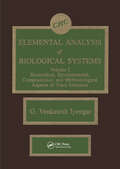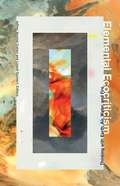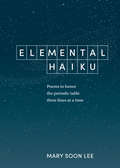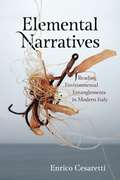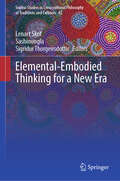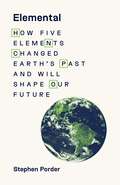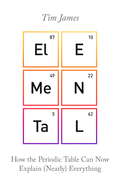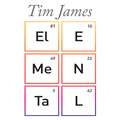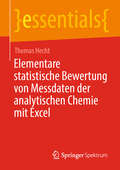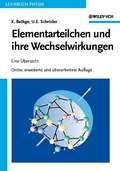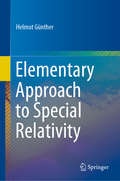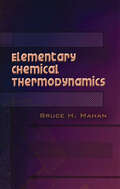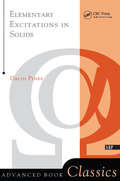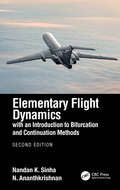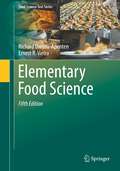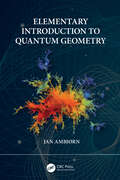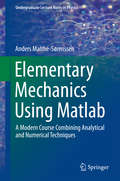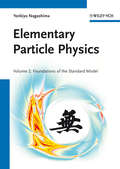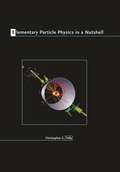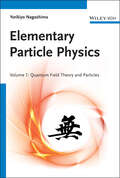- Table View
- List View
Elemental Analysis of Biological Systems: Biological, Medical, Environmental, Compositional, and Methodological Aspects, Volume I
by G. Venkatesh IyengarThe purpose of this volume is to emphasize the fact that biological trace element research is a multidisciplinary science which requires a prudent combination of biological insight and analytical awareness. The text frequently stresses that accurate measurements on biologically and analytically "valid" samples hold the key for success in future investigations. It reminds the analytical scientists and the life sciences researchers that their perceptions should extend beyond conventional limits - namely, the former as generators of data and the latter as interpreters of those findings. This book enables the reader to understand the intricacies of elemental composition studies in biological systems, and also provides a valuable source of information to biologists, biochemists, physicians, nutritionists and related scientific workers who intend to draw meaningful conclusions from the analytical findings.
Elemental Ecocriticism: Thinking with Earth, Air, Water, and Fire
by Jeffrey Jerome Cohen Lowell DuckertFor centuries it was believed that all matter was composed of four elements: earth, air, water, and fire in promiscuous combination, bound by love and pulled apart by strife. Elemental theory offered a mode of understanding materiality that did not center the cosmos around the human. Outgrown as a science, the elements are now what we build our houses against. Their renunciation has fostered only estrangement from the material world. The essays collected in Elemental Ecocriticism show how elemental materiality precipitates new engagements with the ecological. Here the classical elements reveal the vitality of supposedly inert substances (mud, water, earth, air), chemical processes (fire), and natural phenomena, as well as the promise in the abandoned and the unreal (ether, phlogiston, spontaneous generation). Decentering the human, this volume provides important correctives to the idea of the material world as mere resource. Three response essays meditate on the connections of this collaborative project to the framing of modern-day ecological concerns. A renewed intimacy with the elemental holds the potential of a more dynamic environmental ethics and the possibility of a reinvigorated materialism.
Elemental Haiku: Poems to honor the periodic table, three lines at a time
by Mary Soon LeeA fascinating little illustrated series of 118 haiku about the Periodic Table of Elements, one for each element, plus a closing haiku for element 119 (not yet synthesized). Originally appearing in Science magazine, this gifty collection of haiku inspired by the periodic table of elements features all-new poems paired with original and imaginative line illustrations drawn from the natural world. Packed with wit, whimsy, and real science cred, each haiku celebrates the cosmic poetry behind each element, while accompanying notes reveal the fascinating facts that inform it. Award-winning poet Mary Soon Lee's haiku encompass astronomy, biology, chemistry, history, and physics, such as "Nickel, Ni: Forged in fusion's fire,/flung out from supernovae./Demoted to coins." Line by line, Elemental Haiku makes the mysteries of the universe's elements accessible to all.
Elemental Narratives: Reading Environmental Entanglements in Modern Italy (AnthropoScene)
by Enrico CesarettiOver the past century, the Italian landscape has undergone exceedingly rapid transformations, shifting from a mostly rural environment to a decidedly modern world. This changing landscape is endowed with a narrative agency that transforms how we understand our surroundings. Situated at the juncture of Italian studies and ecocriticism and following the recent “material turn” in the environmental humanities, Elemental Narratives outlines an original cultural and environmental map of the bel paese. Giving equal weight to readings of fiction, nonfiction, works of visual art, and physical sites, Enrico Cesaretti investigates the interconnected stories emerging from both human creativity and the expressive eloquence of “glocal” materials, such as sulfur, petroleum, marble, steel, and asbestos, that have helped make and, simultaneously, “un-make” today’s Italy, affecting its socio-environmental health in multiple ways. Embracing the idea of a decentralized agency that is shared among human and nonhuman entities, Cesaretti suggests that engaging with these entangled discursive and material texts is a sound and revealing ecocritical practice that promises to generate new knowledge and more participatory, affective responses to environmental issues, both in Italy and elsewhere. Ultimately, he argues that complementing quantitative, data-based information with insights from fiction and nonfiction, the arts, and other humanistic disciplines is both desirable and crucial if we want to modify perceptions and attitudes, increase our awareness and understanding, and, in turn, develop more sustainable worldviews in the era of the Anthropocene. Elegantly written and convincingly argued, this book will appeal broadly to scholars and students working in the fields of environmental studies, comparative literatures, ecocriticism, environmental history, and Italian studies.
Elemental Narratives: Reading Environmental Entanglements in Modern Italy (AnthropoScene: The SLSA Book Series #6)
by Enrico CesarettiOver the past century, the Italian landscape has undergone exceedingly rapid transformations, shifting from a mostly rural environment to a decidedly modern world. This changing landscape is endowed with a narrative agency that transforms how we understand our surroundings. Situated at the juncture of Italian studies and ecocriticism and following the recent "material turn" in the environmental humanities, Elemental Narratives outlines an original cultural and environmental map of the bel paese. Giving equal weight to readings of fiction, nonfiction, works of visual art, and physical sites, Enrico Cesaretti investigates the interconnected stories emerging from both human creativity and the expressive eloquence of "glocal" materials, such as sulfur, petroleum, marble, steel, and asbestos, that have helped make and, simultaneously, "un-make" today’s Italy, affecting its socio-environmental health in multiple ways. Embracing the idea of a decentralized agency that is shared among human and nonhuman entities, Cesaretti suggests that engaging with these entangled discursive and material texts is a sound and revealing ecocritical practice that promises to generate new knowledge and more participatory, affective responses to environmental issues, both in Italy and elsewhere. Ultimately, he argues that complementing quantitative, data-based information with insights from fiction and nonfiction, the arts, and other humanistic disciplines is both desirable and crucial if we want to modify perceptions and attitudes, increase our awareness and understanding, and, in turn, develop more sustainable worldviews in the era of the Anthropocene. Elegantly written and convincingly argued, this book will appeal broadly to scholars and students working in the fields of environmental studies, comparative literatures, ecocriticism, environmental history, and Italian studies.
Elemental-Embodied Thinking for a New Era (Sophia Studies in Cross-cultural Philosophy of Traditions and Cultures #42)
by Lenart Škof Sigridur Thorgeirsdottir SashinunglaThis collection responds to widespread, complex, and current environmental challenges by presenting eleven original essays on a new elemental-embodied approach in environmental humanities. This approach has a special focus on elemental and indigenous philosophies as well as localized experiences of terrestrial forces: from earthquakes and eruptions to pandemics and natural disasters. Representing a shift in modern Western scientific and disembodied thinking of nature, this edited book approaches the question of relationality and intertwining of human and natural being by utilizing the elemental-embodied methodologies within philosophy of embodiment and nature. Supported by research in cognitive sciences, the contributors represent the experiential and affective turn within research into human cognition. As embodied, the human being is embedded and interacting with all there is. The aim of this edited volume is to indicate new paths toward regaining our access to natural being within usand thus toward reconnecting with the natural environment and the things and beings around us in a new, environmentally enhanced way. It appeals to researchers and students working in many fields, predominantly in philosophy, as well as religious and environmental studies.
Elemental: How Five Elements Changed Earth’s Past and Will Shape Our Future
by Stephen PorderAn ecologist explores how life itself shapes Earth using the elemental constituents we all shareIt is rare for life to change Earth, yet three organisms have profoundly transformed our planet over the long course of its history. Elemental reveals how microbes, plants, and people used the fundamental building blocks of life to alter the climate, and with it, the trajectory of life on Earth in the past, present, and future.Taking readers from the deep geologic past to our current era of human dominance, Stephen Porder focuses on five of life&’s essential elements—hydrogen, oxygen, carbon, nitrogen, and phosphorus. He describes how single-celled cyanobacteria and plants harnessed them to wildly proliferate across the oceans and the land, only to eventually precipitate environmental catastrophes. He then brings us to the present, and shows how these elements underpin the success of human civilization, and how their mismanagement threatens similarly catastrophic unintended consequences. But, Porder argues, if we can learn from our world-changing predecessors, we can construct a more sustainable future.Blending conversational storytelling with the latest science, Porder takes us deep into the Amazon, across fresh lava flows in Hawaii, and to the cornfields of the American Midwest to illuminate a potential path to sustainability, informed by the constraints imposed by life&’s essential elements and the four-billion-year history of life on Earth.
Elemental: How the Periodic Table Can Now Explain (Nearly) Everything
by Tim JamesSELECTED AS ONE OF THE BEST BOOKS OF 2018 BY THE DAILY MAIL 'A hugely entertaining tour of the periodic table and the 118 elements that are the basic building blocks of everything' Daily MailIn 2016, with the addition of four final elements - nihonium, moscovium, tennessine and oganesson - to make a total of 118 elements, the periodic table was finally complete, rendering any pre-existing books on the subject obsolete.Tim James, the science YouTuber and secondary-school teacher we all wish we'd had, provides an accessible and wonderfully entertaining 'biography of chemistry' that uses stories to explain the positions and patterns of elements in the periodic table. Many popular science titles tend to tell the history of scientific developments, leaving the actual science largely unexplained; James, however, makes use of stories to explain the principles of chemistry within the table, showing its relevance to everyday life.Quirkily illustrated and filled with humour, this is the perfect book for students wanting to learn chemistry or for parents wanting to help, but it is also for anyone who wants to understand how our world works at a fundamental level. The periodic table, that abstract and seemingly jumbled graphic, holds (nearly) all the answers. As James puts it, elements are 'the building blocks nature uses for cosmic cookery: the purest substances making up everything from beetroot to bicycles.'Whether you're studying the periodic table for the first time or are simply interested in the fundamental building blocks of the universe - from the core of the sun to the networks in our brains - Elemental is the perfect guide.Website: timjamesscience.com YouTube: timjamesScience Twitter: @tjamesScience
Elemental: How the Periodic Table Can Now Explain (Nearly) Everything
by Tim JamesSELECTED AS ONE OF THE BEST BOOKS OF 2018 BY THE DAILY MAIL 'A hugely entertaining tour of the periodic table and the 118 elements that are the basic building blocks of everything' Daily MailIn 2016, with the addition of four final elements - nihonium, moscovium, tennessine and oganesson - to make a total of 118 elements, the periodic table was finally complete, rendering any pre-existing books on the subject obsolete.Tim James, the science YouTuber and secondary-school teacher we all wish we'd had, provides an accessible and wonderfully entertaining 'biography of chemistry' that uses stories to explain the positions and patterns of elements in the periodic table. Many popular science titles tend to tell the history of scientific developments, leaving the actual science largely unexplained; James, however, makes use of stories to explain the principles of chemistry within the table, showing its relevance to everyday life.Quirkily illustrated and filled with humour, this is the perfect book for students wanting to learn chemistry or for parents wanting to help, but it is also for anyone who wants to understand how our world works at a fundamental level. The periodic table, that abstract and seemingly jumbled graphic, holds (nearly) all the answers. As James puts it, elements are 'the building blocks nature uses for cosmic cookery: the purest substances making up everything from beetroot to bicycles.'Whether you're studying the periodic table for the first time or are simply interested in the fundamental building blocks of the universe - from the core of the sun to the networks in our brains - Elemental is the perfect guide.Website: timjamesscience.com YouTube: timjamesScience Twitter: @tjamesScience
Elemental: How the Periodic Table Can Now Explain (Nearly) Everything
by Tim JamesSELECTED AS ONE OF THE BEST BOOKS OF 2018 BY THE DAILY MAIL 'A hugely entertaining tour of the periodic table and the 118 elements that are the basic building blocks of everything' Daily MailIn 2016, with the addition of four final elements - nihonium, moscovium, tennessine and oganesson - to make a total of 118 elements, the periodic table was finally complete, rendering any pre-existing books on the subject obsolete.Tim James, the science YouTuber and secondary-school teacher we all wish we'd had, provides an accessible and wonderfully entertaining 'biography of chemistry' that uses stories to explain the positions and patterns of elements in the periodic table. Many popular science titles tend to tell the history of scientific developments, leaving the actual science largely unexplained; James, however, makes use of stories to explain the principles of chemistry within the table, showing its relevance to everyday life.Quirkily illustrated and filled with humour, this is the perfect book for students wanting to learn chemistry or for parents wanting to help, but it is also for anyone who wants to understand how our world works at a fundamental level. The periodic table, that abstract and seemingly jumbled graphic, holds (nearly) all the answers. As James puts it, elements are 'the building blocks nature uses for cosmic cookery: the purest substances making up everything from beetroot to bicycles.'Whether you're studying the periodic table for the first time or are simply interested in the fundamental building blocks of the universe - from the core of the sun to the networks in our brains - Elemental is the perfect guide.Website: timjamesscience.com YouTube: timjamesScience Twitter: @tjamesScience
Elementare statistische Bewertung von Messdaten der analytischen Chemie mit Excel (essentials)
by Thomas HechtDieses essential vermittelt eine zeitgemäße und praxisorientierte Einführung in die Messdatenanalyse (nicht nur) für das chemisch-analytische Labor und ermöglicht mit nur wenigen Grundlagen einen Einstieg in die Materie. Der Schwerpunkt liegt auf der Kombination von grundlegender Theorie (Mathematik) und Anwendung (Excel). Das Buch ersetzt weder ein Mathematikbuch noch einen Excel-Kurs. Vielmehr soll es dem interessierten Anwender ermöglichen, Standardaufgaben aus dem analytischen Bereich statistisch zu bewerten. Dabei wird konsequent auf den Einsatz von Excel-Funktionen bei völligem Verzicht auf VBA-Funktionen gesetzt.
Elementarteilchen und ihre Wechselwirkungen: Eine Übersicht
by Klaus Bethge Ulrich E. SchröderDie dritte Auflage dieses bewährten Lehrbuchs bietet in seiner gründlichen Überarbeitung und mit zahlreichen Ergänzungen eine konzise Übersicht über die Physik der Elementarteilchen und ihrer Wechselwirkungen. Die Autoren - beide Wissenschaftler mit langjähriger und umfassender Forschungs- und Lehrerfahrung an renommierten Einrichtungen - stellen in einzigartiger Weise den Kanon der Elementarteilchenphysik gleichzeitig verständlich und übersichtlich zusammen. Das Lehrbuch dient der effizienten Prüfungsvorbereitung, ist aber auch zum Nachschlagen für Diplom- und Doktorarbeiten geeignet, dies nicht zuletzt dank des umfangreichen Tabellenanhangs.
Elementary Approach to Special Relativity
by Helmut GüntherThis book presents an alternative representation of Einstein's Special Theory of Relativity, which makes Special Relativity much more comprehensible. Moreover, one will come across a fundamental relationship between the Special Theory of Relativity and the mechanics of space lattice. In all previous formulations, the Einsteinian special principle of relativity, in one or the other form is used as the starting point for Special Relativity. In correspondence to this principle, one takes it as granted apriori, that all observers independent of their uniform motion to each other measure one and the same propagation velocity of a light signal. This book is thought of as a lecture for physicists, mathematicians and computer scientists and concentrates on the students of these fields. The book should reach a broad circle of interested readers from the fields of natural sciences and philosophy and provide and invigorating experience for engineers.
Elementary Chemical Thermodynamics
by Bruce H. MahanThis straightforward presentation emphasizes chemical applications of thermodynamics as well as physical interpretations, offering students an introduction that's both interesting and coherent. It considers chemical behavior in terms of energy and entropy, and it explains the ways in which the magnitude of energy and entropy changes are dictated by atomic properties. All concepts are presented in a simplified mathematical context, making this an ideal text for a beginning course in thermodynamics.The author considers the first and second laws of thermodynamics in turn, after which he proceeds to applications of thermodynamic principles. He devotes considerable attention to the concept of entropy, emphasizing the interpretation of entropy changes and chemical behavior in terms of qualitative molecular properties. Students gain a familiarity with the entropy concept that will form a solid foundation for later courses and more formal thermodynamic treatments.
Elementary Cluster Analysis: Four Basic Methods that (Usually) Work
by James C. BezdekThe availability of packaged clustering programs means that anyone with data can easily do cluster analysis on it. But many users of this technology don't fully appreciate its many hidden dangers. In today's world of "grab and go algorithms," part of my motivation for writing this book is to provide users with a set of cautionary tales about cluster analysis, for it is very much an art as well as a science, and it is easy to stumble if you don't understand its pitfalls. Indeed, it is easy to trip over them even if you do! The parenthetical word usually in the title is very important, because all clustering algorithms can and do fail from time to time. Modern cluster analysis has become so technically intricate that it is often hard for the beginner or the non-specialist to appreciate and understand its many hidden dangers. Here's how Yogi Berra put it, and he was right: In theory there's no difference between theory and practice. In practice, there is ~Yogi Berra This book is a step backwards, to four classical methods for clustering in small, static data sets that have all withstood the tests of time. The youngest of the four methods is now almost 50 years old: Gaussian Mixture Decomposition (GMD, 1898) SAHN Clustering (principally single linkage (SL, 1909)) Hard c-means (HCM, 1956, also widely known as (aka) "k-means") Fuzzy c-means (FCM, 1973, reduces to HCM in a certain limit) The dates are the first known writing (to me, anyway) about these four models. I am (with apologies to Marvel Comics) very comfortable in calling HCM, FCM, GMD and SL the Fantastic Four. Cluster analysis is a vast topic. The overall picture in clustering is quite overwhelming, so any attempt to swim at the deep end of the pool in even a very specialized subfield requires a lot of training. But we all start out at the shallow end (or at least that's where we should start!), and this book is aimed squarely at teaching toddlers not to be afraid of the water. There is no section of this book that, if explored in real depth, cannot be expanded into its own volume. So, if your needs are for an in-depth treatment of all the latest developments in any topic in this volume, the best I can do - what I will try to do anyway - is lead you to the pool, and show you where to jump in.
Elementary Excitations In Solids: Lectures On Protons, Electrons, And Plasmons (Frontiers In Physics Ser.)
by David PinesThis text continues to fill the need to communicate the present view of a solid as a system of interacting particles which, under suitable circumstances, behaves like a collection of nearly independent elementary excitations. In addition to introducing basic concepts, the author frequently refers to experimental data. Usually, both the basic theory and the applications discussed deal with the behavior of '`'simple' metals, rather than the '`'complicated' metals, such as the transition metals and the rare earths. Problems have been included for most of the chapters.
Elementary Flight Dynamics with an Introduction to Bifurcation and Continuation Methods
by Nandan K. Sinha N. AnanthkrishnanElementary Flight Dynamics with an Introduction to Bifurcation and Continuation Methods, Second Edition is aimed at senior undergraduate and graduate students of aerospace and mechanical engineering. The book uses an optimal mix of physical insight and mathematical presentation to illustrate the core concepts of professional aircraft flight dynamics. An updated version of the aerodynamic model is presented with the corrected definition of rate (dynamic) derivatives, supported with examples of real-life airplanes and related data and by open-source computational tools. It introduces bifurcation and continuation methods as a tool for flight dynamic analysis. FEATURES Covers an up-to-date, corrected, ‘clean’ presentation of the elements of flight dynamics Presents a blend of theory, practice and application with real-life practical examples Provides a unique viewpoint of applied aerodynamicists and aircraft designers Introduces bifurcation and continuation methods as a tool for flight dynamics analysis Includes a computational tool with real-life examples carried throughout the chapters The book is enriched with case studies of flight dynamics of a bird’s flight, of a six-seater rigid-wing airplane from a design perspective, and airship dynamics to highlight the modal behaviour of similar-looking vehicles that are distinct from each other. Excerpts from reviews of the first edition: "Flight dynamics is a topic that can cause difficulties to aerospace engineering students. This text leads the reader gently through the material with plenty of practical examples and student exercises. As such, it is easy to follow the material and to gradually develop a deep understanding of a demanding topic. The book is ideal for undergraduate students and is a good text for graduate students."––James F. Whidborne, Cranfield University, United Kingdom "The book covers all the aspects of flight dynamics traditionally found in such texts interspersed with examples of the treatment of features of current air vehicles....In my opinion, this book covers the subject comprehensively and is a desirable reference source for undergraduates and graduates alike."––R.J. Poole, MRAeS, The Aeronautical Journal, June 2014 "The book design and the methodology of interpretation are directed to a wide range of target audience/population interested in studying the dynamics of flight. Given the scale and organization of information, the book will also be a useful tool in the analysis of flight dynamics for professionals in this field. The book is sure to appeal to anyone interested in the dynamics of flight."––Jaroslav Salga, Advances in Military Technology, June 2014
Elementary Food Science (Food Science Text Series)
by Richard Owusu-Apenten Ernest R. VieiraFollowing the success of the popular introductory text,Elementary Food Science(5th edition) coversabroad range of food science topics organized infour parts; Part (1)Interrelated food science topics, Part (2)Food safety & sanitation, Part (3)Food preservation and processing and Part (4)Handling & processing of foods. The opening two chapters discuss what food science actually is, the significanceforsociety, and the large contribution of the food industry to jobs and revenue in the USA and globally. Succeeding chapterscover food regulatory agencies, food labels, food quality and sensory evaluation, and consumer food literacy. Part (2)hastwo new chapters explaininghow microbes affect food quality,and alsofoodborne disease outbreaks; GMP is described independently and as a prerequisite for HACCP, VACCP andTACCPfood-safety management systems. Part (3) containstwo new chapters dealing with basic aspects of food processing, and the quality of dried foods. Part (4) covershandling and processing major food commodity groups (meat, dairy products, poultry and eggs, fish and shellfish, cereal grains, bakery products, fruits and vegetables, sugar confectionary). A new final chapter coversthe foodservice industry. The text highlights food science links with industry uniquelyusing the North American Industry Classification System (NAICS). Overall, the book is thoroughly modernized with over 1500 references cited in recognition of thousands of named food scientists and other professionals. The target readership remain unchanged for the current edition, i.e. Students of food science fromsenior high school, colleges or universities. Sections of the book will also appeal toadvanced readers from other disciplines with perhaps little or noprior food science experience. Additionally, readers covering the intersection of food science with culinary arts, foodservices, and nutritionor public health will find the book useful.
Elementary Introduction to Quantum Geometry
by Jan AmbjornThis graduate textbook provides an introduction to quantum gravity, when spacetime is two-dimensional. The quantization of gravity is the main missing piece of theoretical physics, but in two dimensions it can be done explicitly with elementary mathematical tools, but it still has most of the conceptional riddles present in higher dimensional (not yet known) quantum gravity. It provides an introduction to a very interdisciplinary field, uniting physics (quantum geometry) and mathematics (combinatorics) in a non-technical way, requiring no prior knowledge of quantum field theory or general relativity. Using the path integral, the chapters provide self-contained descriptions of random walks, random trees and random surfaces as statistical systems where the free relativistic particle, the relativistic bosonic string and two-dimensional quantum gravity are obtained as scaling limits at phase transition points of these statistical systems. The geometric nature of the theories allows one to perform the path integral by counting geometries. In this way the quantization of geometry becomes closely linked to the mathematical fields of combinatorics and probability theory. By counting the geometries, it is shown that the two-dimensional quantum world is fractal at all scales unless one imposes restrictions on the geometries. It is also discussed in simple terms how quantum geometry and quantum matter can interact strongly and change the properties both of the geometries and of the matter systems. It requires only basic undergraduate knowledge of classical mechanics, statistical mechanics and quantum mechanics, as well as some basic knowledge of mathematics at undergraduate level. It will be an ideal textbook for graduate students in theoretical and statistical physics and mathematics studying quantum gravity and quantum geometry. Key features: Presents the first elementary introduction to quantum geometry Explores how to understand quantum geometry without prior knowledge beyond bachelor level physics and mathematics. Contains exercises, problems and solutions to supplement and enhance learning
Elementary Mechanics Using Matlab
by Anders Malthe-SørenssenThis book - specifically developed as a novel textbook on elementary classical mechanics - shows how analytical and numerical methods can be seamlessly integrated to solve physics problems. This approach allows students to solve more advanced and applied problems at an earlier stage and equips them to deal with real-world examples well beyond the typical special cases treated in standard textbooks. Another advantage of this approach is that students are brought closer to the way physics is actually discovered and applied, as they are introduced right from the start to a more exploratory way of understanding phenomena and of developing their physical concepts. While not a requirement, it is advantageous for the reader to have some prior knowledge of scientific programming with a scripting-type language. This edition of the book uses Matlab, and a chapter devoted to the basics of scientific programming with Matlab is included. A parallel edition using Python instead of Matlab is also available. Last but not least, each chapter is accompanied by an extensive set of course-tested exercises and solutions.
Elementary Particle Physics
by Yorikiyo NagashimaThis second volume of Elementary Particle Physics, "Foundations of the Standard Model", concentrates on the main aspects of the Standard Model by addressing developments from its establishments to recent progress and some future prospects. Two subjects are clearly separated which cover dynamics of the electroweak and strong interactions, but basso continuo throughout the book is a bridge between theory and experiments. All the basic formulas are derived from the first principle, and corrections to meet the experimental accuracy are explained. This volume is a logical step up from volume I but can also be considered and used as an independent monograph for high energy and theoretical physicists, as well as astronomers, graduate students and lecturers in physics.
Elementary Particle Physics in a Nutshell (In a Nutshell #11)
by Christopher G. TullyAn introduction to high-energy physics that prepares students to understand the experimental frontierThe new experiments underway at the Large Hadron Collider at CERN in Switzerland may significantly change our understanding of elementary particle physics and, indeed, the universe. This textbook provides a cutting-edge introduction to the field, preparing first-year graduate students and advanced undergraduates to understand and work in LHC physics at the dawn of what promises to be an era of experimental and theoretical breakthroughs.Christopher Tully, an active participant in the work at the LHC, explains some of the most recent experiments in the field. But this book, which emerged from a course at Princeton University, also provides a comprehensive understanding of the subject. It explains every elementary particle physics process—whether it concerns nonaccelerator experiments, particle astrophysics, or the description of the early universe—as a gauge interaction coupled to the known building blocks of matter. Designed for a one-semester course that is complementary to a course in quantum field theory, the book gives special attention to high-energy collider physics, and includes a detailed discussion of the state of the search for the Higgs boson.Introduces elementary particle processes relevant to astrophysics, collider physics, and the physics of the early universeCovers experimental methods, detectors, and measurementsFeatures a detailed discussion of the Higgs boson searchIncludes many challenging exercisesProfessors: A supplementary Instructor's Manual which provides solutions for Chapters 1-3 of the textbook, is available as a PDF. It is restricted to teachers using the text in courses. To obtain a copy, please email your request to: Ingrid_Gnerlich "at" press.princeton.edu.
Elementary Particle Physics: An Intuitive Introduction
by Andrew J. LarkoskiThis modern introduction to particle physics equips students with the skills needed to develop a deep and intuitive understanding of the physical theory underpinning contemporary experimental results. The fundamental tools of particle physics are introduced and accompanied by historical profiles charting the development of the field. Theory and experiment are closely linked, with descriptions of experimental techniques used at CERN accompanied by detail on the physics of the Large Hadron Collider and the strong and weak forces that dominate proton collisions. Recent experimental results are featured, including the discovery of the Higgs boson. Equations are supported by physical interpretations, and end-of-chapter problems are based on datasets from a range of particle physics experiments including dark matter, neutrino, and collider experiments. A solutions manual for instructors is available online. Additional features include worked examples throughout, a detailed glossary of key terms, appendices covering essential background material, and extensive references and further reading to aid self-study, making this an invaluable resource for advanced undergraduates in physics.
Elementary Particle Physics: Quantum Field Theory and Particles V1
by Yorikiyo NagashimaMeeting the need for a coherently written and comprehensive compendium combining field theory and particle physics for advanced students and researchers, this book directly links the theory to the experiments. It is clearly divided into two sections covering approaches to field theory and the standard model, and rounded off with numerous useful appendices. A timely volume for high energy and theoretical physicists, as well as astronomers, graduate students and lecturers in physics. Volume 2 concentrates on the main aspects of the Standard Model by addressing its recent developments and future prospects. Furthermore, it gives some thought to intriguing ideas beyond the Standard Model, including the Higgs boson, the neutrino, the concepts of the Grand Unified Theory and supersymmetry, axions, and cosmological developments.
Elementary Particles and The Laws of Physics: The 1986 Dirac Memorial Lectures
by Steven Weinberg Richard P. FeynmanPerhaps the two most important conceptual breakthroughs in twentieth century physics are relativity and quantum mechanics. Developing a theory that combines the two seamlessly is a difficult and ongoing challenge. This accessible book contains intriguing explorations of this theme by the distinguished physicists Richard Feynman and Steven Weinberg. Richard Feynman's contribution examines the nature of antiparticles, and in particular the relationship between quantum spin and statistics. In his essay, Steven Weinberg speculates on how Einstein's theory of gravitation might be reconciled with quantum theory in the final laws of physics. Both these Nobel laureates have made huge contributions to fundamental research in physics, as well as to the popularization of science. Anyone interested in the development of modern physics will find this a fascinating book.
